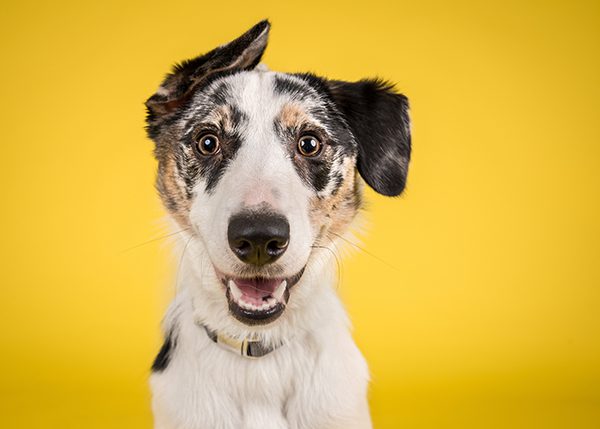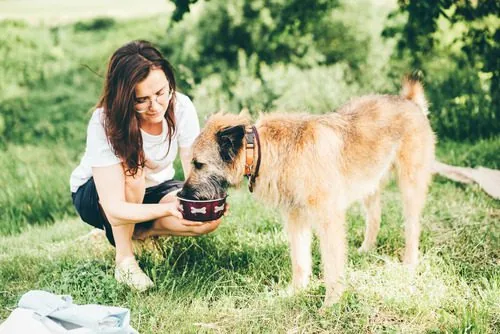Can Dogs See Color? What Pet Owners Are Begging to Know
Have you ever questioned if your dog can see color? Your dog cannot see as many colors as you do, but they can see specific colors and recognize brightness.
Dogs’ color vision is limited to colors and shades of blue and yellow, and they cannot see any red or green color. When picking toys for your pup, stick to colors they can identify and enjoy.

The eyes of a dog are different than the eyes of a human. However, you can train a dog to respond to brightness and color. When you read the article below, you will find out more about what colors dogs can see.
Can Dogs See in Full Color?
Dogs are not colorblind, (see video), contrary to popular belief. Dogs can see some color, but they do not see color the way humans do. This difference is because the human eyes and the dog’s eyes are built differently. While human eyes have three color receptors, dogs only have two.
Humans also have more cones than dogs, but dogs have more rods, which allows them to see better than humans in the dark. Rods assist with low light vision, and dogs have larger lenses and corneal surfaces.
The lens sits right behind the iris of the eye. It is intended for focusing nearby or faraway items on the retina. The cornea focuses light on the retina at the back of the eye. It serves as a transparent shield that focuses and delivers light through the pupil.
The rods and cones in the retina are responsible for your pup’s vision. Rods function better in dim lighting and can identify motion and shapes. Cones work better in clear, bright light, which helps dogs to distinguish what colors they can recognize or see.
What Colors Do Dogs See Best?
Dogs can only see certain colors. They can recognize:
- Blue
- Yellow
- Gray
Dogs also cannot see colors as intensely as humans do. For example, when a human sees green, a dog sees light yellow. If your pup loses their favorite yellow ball in the grass, they may not be able to distinguish between the ball and the grass.
If your dog cannot tell the difference between green and yellow, they will not be able to see their ball. You will have to help your pup find it. You may want to try using a blue ball next time. Your dog can tell the difference between blue and yellow.
Many people purchase red toys for dogs because it is a bright, playful color. However, when a dog looks at red, they see more of a dark brown color. People also assume that dogs like orange. However, when a dog looks at orange, they see a dull gold color.
Researchers surmise that dogs depend on the brightness or darkness of an object instead of color when making judgments.
Can Color Therapy Work on Dogs?
The most perceptible colors to dogs are yellow and blue. Dogs are naturally drawn to these colors. Just like humans have their favorite colors, dogs tend to prefer colors that stand out to them. Research has suggested that dogs prefer blue out of all the colors because it is calming to them.
Color therapy, otherwise known as chromotherapy, is the use of color to impact:
- Moods
- Emotions
- Behaviors
- Health
Color therapy is an ancient method of treatment, and it can work on people and pets. The purpose is to influence your dog’s energy field to promote healing. When performing color therapy on animals, you can use colored gels found in art or camera supply stores.
These should be placed in front of a light bulb to emit colors. The animal will respond to certain colors.
The chakras are said to have something to do with the colors that have the propensity to heal them.
While color therapy may be beneficial to dogs, it is an alternative therapy and is not a replacement for quality veterinary care.
What Does Research Indicate about Dogs and Color?
Research conducted for a paper called “Proceedings of the Royal Society B” 1 included a small group of eight dogs. The study proved that the dogs were much more likely to recognize a piece of paper by its color than its brightness level, which infers that dogs may be aware of some of the colors of everyday items.
During the experiment, the researchers printed out four pieces of paper. The papers were colored:
- Dark Yellow
- Light Yellow
- Dark Blue
- Light Blue
Because they used these two different colors and based the darkness levels on what dogs’ eyes are sensitive to, the dogs could distinguish between the papers in two ways. These include whether they were dark or light and whether they were blue and yellow.
For the experiment, the researchers used two papers that differed in color and brightness.
These include dark yellow and light blue paper and light yellow and dark blue paper. The tester placed the papers each in front of a feedbox that contained a piece of raw meat.
Only one box was unlocked so the dog could get to it, and the identical paper was put in front of the box every time. With each trial, the dog was permitted to attempt to open only one of the boxes and then be stopped immediately.
After only a few trials, each dog learned how to consistently pick the correct box, demonstrating that the dog had been trained to associate an unlocked box of meat with one of the specific pieces of paper.
All the pups utilized for the study memorized the color associated with the raw meat, not whether the color was dark or light.
Further examination showed that the dogs could memorize the brightness of the piece of paper and associate it with the raw meat. This study proves that dogs can be trained to use brightness as a cue and see color.
Dogs Can See Color, But Not Nearly As Much As Us
Assuming that dogs can only see in black and white is an incorrect belief. Dogs may not be able to see as well as humans, but they can see a limited spectrum. Dogs tend to gravitate to the colors they do see, which are yellow and blue. The next time you play fetch with your canine companion, make sure you use a color that will stand out.
Recent Posts
6 Possible Causes for Your Cat’s Sneezing
6 Possible Causes for Your Cat’s Sneezing Cats are known for their curious and playful nature, but…
Why is My Dog Eating Grass?
Why is My Dog Eating Grass? Dogs are known for their curious behaviors, and one that often…
Can Dogs Eat Marshmallows?
Can Dogs Eat Marshmallows? Marshmallows are a popular treat for many people, but pet owners often wonder,…
Can Dogs Get Sunburn?
Can Dogs Get Sunburn? As summer approaches and the days get longer, many pet owners look forward…
Dog Dehydration: Symptoms, Treatment and Prevention
Dog Dehydration: Symptoms, Treatment and Prevention Dehydration in dogs is a common but often overlooked condition that…
About Boughton Square Animal Clinic
Since 1979, Boughton Square Animal Clinic has served Bolingbrook, IL and surrounding communities as both a veterinary care provider and a devoted partner in treating your animal family members for life.






